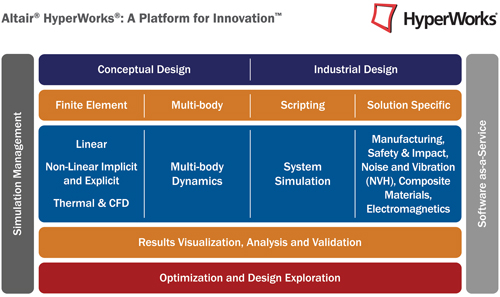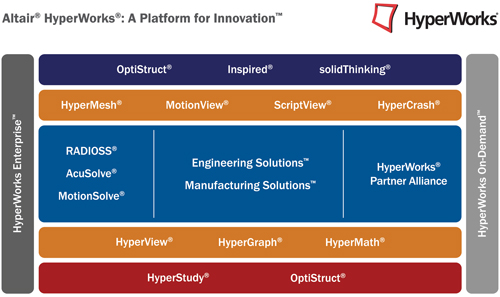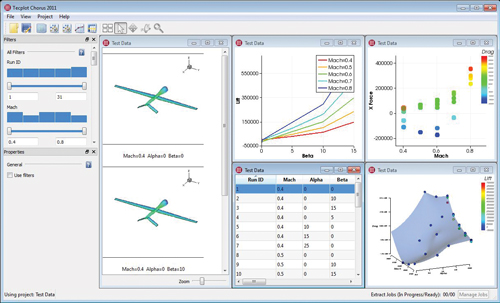Latest News
December 1, 2011
By Pamela J. Waterman
Have your design simulations hit a non-converging wall? Does your lineup of post-processing tasks make morning traffic look light? Your engineering skills may be as sharp as ever, but your software may need retooling to handle today’s complex problems.
See whether you recognize these symptoms: The basic analysis tools that came with your CAD system can’t help you with a specialized analysis. Your meshing tool is causing element failures. Your simulated results don’t match lab or field-test results. And the last person in your department who understood the in-house solver code just retired.
It’s time to reconfigure your simulation workflow—and the best solution may just involve building it yourself.

A breakout of the many paths possible for taking a full finite element analysis
project from design through optimization. Users may choose an all-in-one
software package, separate packages designed for interoperability or a
combination of in-house and commercial solutions. Image courtesy of Altair Engineering.
Mesh, Solve, Visualize, Repeat
Whether for finite element analysis (FEA), computational fluid dynamics (CFD) or multiphysics, the workflow of model-mesh-solve-understand-remodel remains the norm. You may use an all-in-one package or separate pre- and post-processors and one or two classic solvers. How can you recognize it’s time for change, and what tools will improve the process?
Jeff Brennan, chief marketing officer for Altair (known for its HyperWorks analysis products), identifies a simulation maturity model many engineers now face, starting with interfacing perhaps to a customer’s CAE tool, adding non-linear analysis, writing scripts for process automation and lastly, defining a business model for scaling software across an enterprise. All these factors influence moving from today’s solution to tomorrow’s.
Solvers, the Analysis Workhorses
For small and medium businesses, an integrated package such as NEi Fusion from NEi Software may offer just the right combination. For example, SolidWorks’ 3D solid-modeling tools “fused” with NEi Nastran solvers for accurate solutions at an affordable price. The company offers a natural growth path: As projects increase in complexity, users can move to NEi Nastran within the Femap pre-processing environment (via Siemens PLM Software) and still find the tools to be familiar.
Expanding beyond CAD, designers are exploring tools that support more sophisticated analyses. As Vipul Kinariwala, Cranes Software NISA product manager, says, “People are finding that the basic analysis packages that came with their CAD systems are not sufficient—that the tools available from a single vendor are very good for doing basic things, but not for specific, more advanced tasks.”
Kinariwala also points out, “Where (designers) were making simple shortcuts before, they now want to account for realistic simulation; they need to have more powerful hardware and more powerful software, which are niche or single-application-oriented packages.”
One way to achieve this power is with add-on modules. For example, users can buy Cranes Software’s NISA 17.1 basic FEA package, then add just the Heat or Rotor modules as needed. The company is also considering short-term leasing.
Even more issues are driving users of high-end, internally developed codes to a commercial package. In-house software is not cheap to write and maintain; the experts involved may all be retiring; and the solver itself may lack the required power. Dale Berry, SIMULIA director of technical marketing, expands upon this scenario: “Maybe the legacy software is linear only, using methods based on ’90s technology. But today’s customers are running more complicated and much larger problems—for example, a 50-million-DOF powertrain problem on a 128-node cluster. You need a commercial tool to tackle those kinds of problems.”
Berry knows that many customers may need to define a unique material behavior or do exactly the same analysis sequence over and over again. SIMULIA’s software allows user-created subroutines that add such functions beyond the Abaqus Unified FEA product suite, its multiphysics capabilities and add-on tools. Abaqus also helps users extend analysis capabilities through linking commercial products together via a host of strategic partners.

The range of software analysis products from Altair Engineering addresses
every stage in the linear/non-linear structural-analysis process. CFD
capabilities are also included with the recent addition of AcuSolve.
Image courtesy of Altair Engineering.
COMSOL, with its COMSOL Multiphysics family, offers a wide range of functions internally. Still, the company extensively supports users who want to combine its products with other packages—offering no fewer than six different approaches. If you ask Bjorn Sjodin, COMSOL vice president of product management, he’ll give you a great run-down of each. Here are three to start:
1. Use COMSOL’s LiveLink products for major CAD products to work simultaneously with CAD within the COMSOL environment.
2. Employ COMSOL’s LiveLink for MathWorks MATLAB to link vast amounts of legacy code with COMSOL and other simulation software from inside the MATLAB environment.
3. Build an expert-driven user interface that others can easily implement using the new Physics Interface Builder (currently in beta testing).
Altair’s suite of HyperWorks products covers the gamut of modeling (HyperMesh), analysis (RADIOSS and AcuSolve), visualization (HyperView), and optimization (OptiStruct), to mention a few. Altair’s Brennan says that the topic of interoperability with external packages is “something our company has lived and breathed for 20 years.” Its strength is in handling the gory details in creating vertical solutions, helping users build their own process from conceptual design through manufacturing simulation. In fact, the task the company spends the most on is interface design to dozens of CAD and CAE systems.
According to Barry Christenson, ANSYS director of product marketing, the need to interface with other physics, incorporate the properties of a proprietary material or add an industry-specific function are all reasons that users may “build their own” system. “But,” he says, “as commercial simulation suppliers, if we’re doing our jobs right, we should be eliminating the need for people to have to bring together general-purpose kinds of software tools. In terms of general-purpose flow, with more integrated solutions, the need for massive customization should be reduced.”
In the meantime, ANSYS input file-formats are open, so users can write out input files fairly easily in a third-party tool to run through ANSYS solvers. ANSYS also offers scripting options through its Workbench product, as well as more direct solution extensions with its 80-plus partner companies.
Long-time classic Siemens PLM Software’s CAE offerings include NX CAE and NX Nastran. Ravi Shankar, Siemens NX CAE marketing manager, says NX Nastran can be a complementary solver—particularly for specialized post solutions such as durability evaluation.
“NX Nastran output formats are well known standards,” he says. “NX Nastran can also be easily customized with the direct matrix abstraction program (DMAP) software language capability.” He offers coupling hydroelastic and structural-dynamic solutions as examples.
Meshing and Visualization Tools
One vendor calls meshing “a critical pain point;” another terms post-processing “a necessary evil.” If done poorly, these tasks at best create a bottleneck—and at worst, produce meaningless answers. A clearly recurring thread in vendor discussions is that, to help more users quickly produce useful results, especially on short-term projects, performing both of these stages well is crucial.

Tecplot’s new Chorus simulation analytics tool works with CFD results to help
users identify trends and anomalies across tens of thousands of runs. Chorus,
which includes Tecplot’s 360 software, sits downstream of the post-processor
and lets users run a wide range of analytics, from tracking a custom-defined
value or function to extracting a convergence history. Image courtesy of Tecplot.
Pre-processing software guides users to setting up an accurate and effective mesh. Such tools must be highly interoperable with multiple CAD packages, while also being solver neutral. Examples include Siemens’ Femap, MSC Software’s Patran, ETA’s PreSys, and Pointwise’s Gridgen/Pointwise. The first three packages address a wide range of structural analysis tasks; the last is focused almost exclusively on CFD applications.
Al Robertson, Siemens Femap marketing manager, sees the need for more accurate meshing to represent real-world structures.
“We’ve seen where, for the simpler analyses, users continue to use their original FE capability—often with SolidWorks Simulation or Autodesk Simulation—but when they need to perform dynamics or something more advanced, they use solver-neutral Femap with NX Nastran,” Robertson says. Femap also offers extensive post-processing and visualization functions, has an application program interface (API) to help with third-party integration, and writes files directly to ANSYS and LS-Dyna.
Six years ago, Pointwise decided to completely overhaul its Gridgen meshing package to give it a modern interface and more functions, naming the expanded package simply Pointwise. This pre-processor attracts users with a range of needs, such as large and/or more accurate grids, more control instead of automated generation, and easy integration to more than one solver. Rick Matus, Pointwise vice president of sales and marketing, says the software’s interoperability is a strong point, with output to more than 40 CFD packages.
Looking to the other side of a CFD solver, Steve Legensky, general manager and founder of Intelligent Light, sees a place for both bundled post-processors and for his advanced Fieldview 13 product. “The packaged version is OK for people not on mission-critical jobs,” he observes. “Other users view fluid flow as the heart of a problem.”
Fieldview is targeted to those special, vertical workflows such as when designing turbomachinery, where you absolutely need to accurately account for unsteady flow. A customizable graphical user interface (GUI) simplifies solver integration, and the company’s tech model is well suited to cloud computing to handle huge amounts of data.
CEI Software’s EnSight streams data through its client-server architecture, allowing it to handle extremely large datasets such as from HPC petascale clusters, according to Darin McKinnis, vice president of Sales and Marketing for CEI Software.
EnSight also offers volume rendering, a visual way to view complex flow phenomena such as combustion, mixing, and turbulence. While CEI’s EnSight takes on both CFD and FEA post-processing and visualization, the company also offers a free version of EnSight in its CFD-specific version, EnSight CFD.
Tecplot 360, a numerical simulation and CFD visualization package, has been that company’s flagship product since 1988. Tecplot President Mike Peery talks about the importance of post-processing software that can handle extremely large projects, such as aircraft wing design, where analysts easily generate 5,000 to 15,000 CFD runs.
Tecplot Chorus, the company’s newest product, includes 360—but also manages all the details, allowing engineers to identify trends in physics across thousands of runs. Peery notes that this function differs from optimization because it does far more than identify extrema.
Done with care, users shouldn’t be afraid to try one from Column A, one from Column B and so on, to improve the analysis process all the way through optimization. It’s time for change. As SIMILIA’s Berry quips, “If I’m using five-year-old methods, and my competitors are using today’s methods, I’m stuck.”
Contributing Editor Pamela Waterman, DE’s simulation expert, is an electrical engineer and freelance technical writer based in Arizona. You can send her e-mail to [email protected].
MORE INFO
Subscribe to our FREE magazine, FREE email newsletters or both!
Latest News
About the Author
Pamela Waterman worked as Digital Engineering’s contributing editor for two decades. Contact her via .(JavaScript must be enabled to view this email address).
Follow DE





